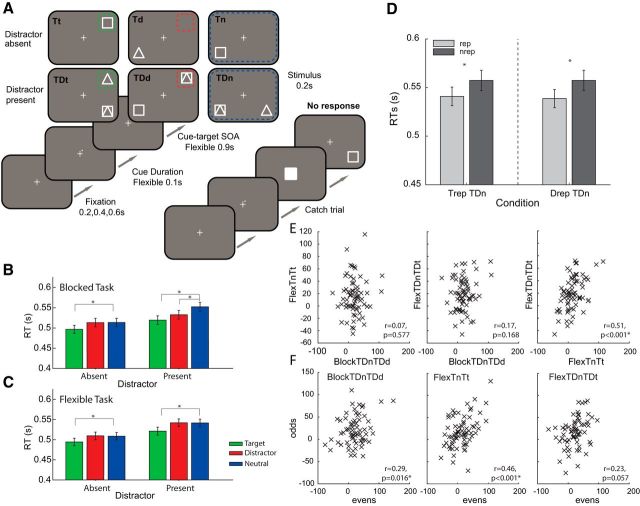Figure 2.
Illustrative task schematic and results for Experiment 2. A, Each trial began with a fixation cross, randomly jittered in duration. The fixation cross then turned from gray to white, signaling the onset of the trial. In the Flexible task, a cue was presented in the corner of the fixation cross, which predicted the forthcoming cued stimuli in Target and Distractor cued blocks. In Neutral cued trials, the cue was presented randomly. In the Blocked task, no explicit cue was presented as such fixation-target stimulus-onset asynchrony (SOA) is 1000 ms. Subjects were instructed the presence or absence of the distractor the beginning of each block. In the Blocked task, subjects were also instructed to the cued stimulus location. Location was valid for all trials within a block. Targets were either triangles or squares, whereas distractors were the two superimposed shapes. B, Mean of the individual median RTs (error bars indicate ±1 SEM) for Blocked version of the task for the 3 different Cue Types (green represents target; red represents distractor; blue represents neutral) in the distractor present and absent conditions. C, The same as in B, but for the Flexible version of the task. D, Mean of the individual median RTs (error bars indicate ±1 SEM) for pooled Blocked and Flexible neutral cueing condition for the trials in which the target stimulus (left) or distractor stimulus (right) was repeated in the same location relative to nonrepeat trials. E, Correlations between blocked distractor cueing effects and flexible target enhancement effects (left and middle) and between flexible target enhancement effects on blocks of trials with and without the distractor stimuli (right). F, Correlations between even and odd trials for each subcomponent of correlations shown in E. TrepTDn, Target repeats and distractor present on neutral trials; DrepTDn, Distractor repeats and distractor present on neutral trials; nrepTDn, Neither target nor distractor stimuli repeats; FlexTnTt, distractor absent target cueing RT effects in the flexible task; FlexTDnTDt, distractor present target cueing RT effects in the flexible task; BlockTDnTDd, distractor present distractor cueing RT effects in the Blocked task. *Indicates significance of statistical tests.

